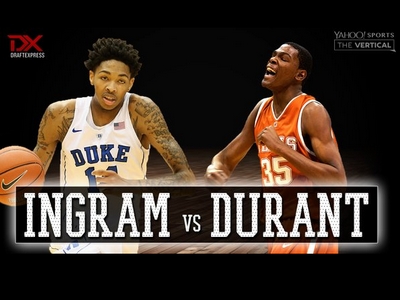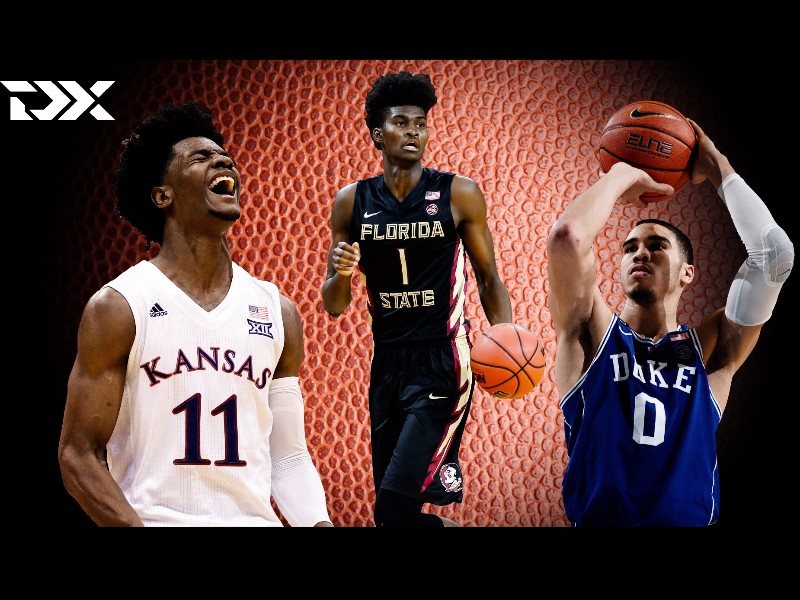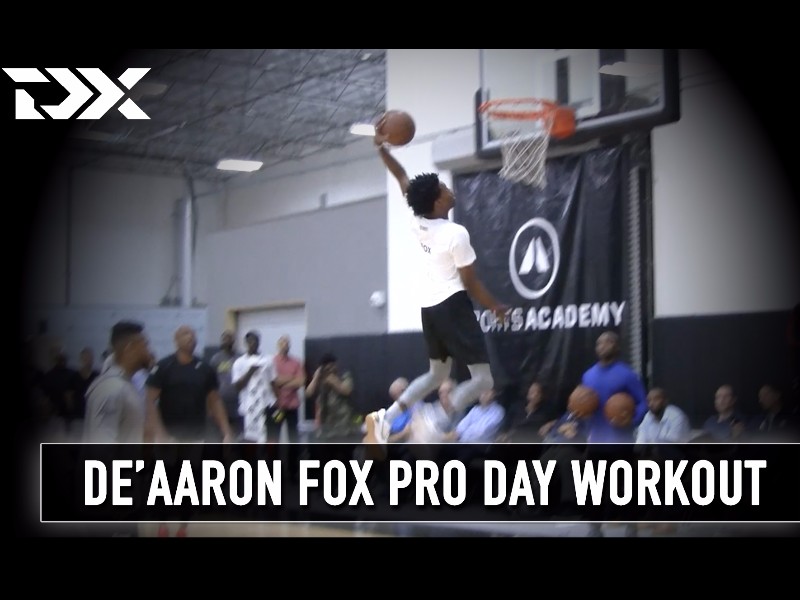This article was originally published on the Vertical on April 1st. Find it here in it's original format.
In August 2014, Brandon Ingram told DraftExpress at the Under Armour Elite 24 in New York that he models his game after Austin Daye, Tayshaun Prince and, Kevin Durant, of course.
The last comparison seemed like a pipe dream. At the time, Ingram was two inches shorter than Durant and was hardly considered an elite-level recruit. A career path somewhere in between Daye and Prince appeared to be most realistic.
In the 18 months since, Ingram has accomplished the following: He grew two inches, ascended to the fourth-ranked player in the 2015 recruiting class, helped lead a ho-hum Duke team to the Sweet 16 and cemented himself as the potential No. 1 pick in the 2016 NBA draft.
At 6-foot-9½ with the standing reach of an NBA center, an excellent handle, the fluidity of a guard and the stroke of a sharpshooter, the Durant comparisons look less and less ludicrous.
Here's a breakdown of how the Kinston, N.C., native compares to one of the best basketball players in the world when he was entering the NBA.
NCAA PRODUCTION
Kevin Durant
Recruiting Services Consensus Index Ranking: No. 2
Playing his entire freshman season at Texas at age 18, Durant born on Sept. 29 averaged 25.8 points, 11.1 rebounds, 1.9 steals, 1.9 blocks, and 35.5 minutes in 35 games. He became the first freshman in NCAA history to be named National Player of the Year.
According to the DraftExpress Database, which dates to 2000, no other freshman has ever averaged 25 points per game on 50 percent shooting from 2-point range and 40 percent shooting from 3-point range (at least six attempts per 40-minute pace).
Durant scored 30 points or more in 11 of his 35 games.
Brandon Ingram
Recruiting Services Consensus Index Ranking: No. 4
At age 18, Ingram born on Sept. 2 averaged 17.1 points, 6.8 rebounds, 1.9 assists, 1.1 steals and 1.3 blocks in 34 games playing 34.2 minutes per game.
Ingram is the only sub-19-year-old player in the DraftExpress Database to average at least 20 points, two assists, eight rebounds, and 2.5 3-point makes per 40 minutes while shooting better than 40 percent from 3-point range.
Ingram scored 25 points or more in seven of 34 games but never topped 30 points.
PHYSICAL PROFILE
Durant
2006 Nike Hoop Summit (17.5 years old): 6-9 barefoot, no weight given, 7-4 wingspan, 9-1/2 standing reach.
Ingram
2015 Nike Hoop Summit (17.6 years old): 6-8 barefoot, 196 pounds, 7-3 wingspan, 9-1 1/2 standing reach.
More than 14 months later at the 2007 NBA predraft camp, Durant measured 6-10 1/4 in shoes with a 7-4 3/4 wingspan and 9-2 standing reach and weighed 210 pounds. According to the DraftExpress Database, Durant is the only non-traditional big man in the NBA with at least a 9-1 1/2 standing reach. Ingram will be the second. (There are no official measurements for Milwaukee's Giannis Antetokounmpo).
While still very slight, Durant was a hair stronger and taller than Ingram at the same age. Durant had more quickness and pop as a leaper as well.
THE SKILLS
Catch and Shoot
From a pure numbers standpoint, Ingram has the slight edge on Durant. He made more threes per 40 minutes while shooting a better percentage and produced more points per possession while taking 37 more catch-and-shoot jumpers.
In terms of mechanics and value as a catch-and-shoot player, Durant has the edge. It wasn't difficult to see Durant evolving into one of the best shooters in basketball. He had NBA range as an 18-year-old and was a more versatile shooter than Ingram with better skill coming off screens and dribble handoffs. Ingram certainly shows a lot of promise, but he doesn't quite display the same range, touch and shot-making ability that Durant did.
Isolation Scoring
Ingram flashed a lot of potential as a one-on-one shot creator, scoring 0.94 points per possession to Durant's 0.88 in isolation situations. Ingram's shooting stroke sets up the drive, and he has very advanced footwork for his level of development. Neither player was particularly efficient shooting off the dribble, but Durant was more advanced, regularly using hesitation pull-ups, crossovers and step-backs to create space.
Durant was also a little bit quicker off the bounce, playing with solid burst while shifting gears seamlessly. Ingram is often criticized for not being able to turn the corner in shot-creation situations, an issue that Durant also dealt with at times because of his size. As Ingram continues to mature physically, he should be able to keep his defender on his hip and stride all the way to the rim. Durant was as prolific of a one-on-one scorer as you'll see from an 18-year-old. Ingram certainly isn't as advanced as Durant was, but he has a nice foundation to build on.
Pick-and-Roll Play
This season Durant has used more pick-and-roll possessions than any other play type and ranks in the 90th percentile in points per possession. Yet as an 18-year-old freshman, pick-and-roll ballhandling made up only 3.1 percent of his offense, yielding 0.542 points per possession.
Statistically at least, Ingram is further ahead as a pick-and-roll player. He has room to improve his pull-up game and creativity attacking the rim (he only scored 0.716 points per possession out of ball screens), but Ingram can make a three if the defense goes under the screen, get into the mid-range if the guard fights over, and stride to the rim if he finds a seam. Maybe the most impressive part of his pick-and-roll game is his potential as a passer. He plays with great pace, can see over the top of the defense and handles defensive pressure well. Ingram may not have Durant's upside as a pick-and-roll player, but he's slightly more versatile operating off ball screens at the same level of development.
Finishing at the Rim
Both Ingram and Durant weren't great around the rim as freshmen because of their lack of strength. Durant is a better leaper off one foot and was able to drop in floaters from different angles. That's a shot Ingram doesn't have at this stage. Ingram is more of a two-feet jumper around the rim, gathering himself even when he has a straight line to the rim. On the positive side, Ingram doesn't shy away from contact even with his thin body. He has not reached his athletic potential and yet is very good with his left hand around the rim. He'll benefit from continuing to get craftier around the rim to make up for his lack of pop.
Post Game
Durant's post game was extremely polished for a freshman; Ingram didn't spend a whole lot of time on the block. Durant was lethal shooting turnarounds over either shoulder, as his high, often variable release point was nearly impossible to block. Durant also had a counter to his fall-away and could face up and attack from the mid-post as well. Ingram has impressive footwork and can make a turnaround over either shoulder, but he isn't on the same level as Durant as a post scorer.
Offensive approach
Durant and Ingram differ in their offensive approach. Durant was a mega-scorer who could and would score from anywhere on the court. Ingram is much more naturally unselfish. Durant had vision as a freshman and has developed into a tremendous passer, averaging 5.5 assists per 40 minutes this season. Ingram has shown flashes of taking over, but his passing and feel for the game might end up being almost as valuable as his scoring ability down the road.
All in all, Ingram isn't the same level of prospect that Durant was despite having many similarities. With that said, Ingram has come a long way over the past 18 months, and with his physical tools and foundational skill set, he is, in our view, the top prospect in the 2016 NBA draft.
In August 2014, Brandon Ingram told DraftExpress at the Under Armour Elite 24 in New York that he models his game after Austin Daye, Tayshaun Prince and, Kevin Durant, of course.
The last comparison seemed like a pipe dream. At the time, Ingram was two inches shorter than Durant and was hardly considered an elite-level recruit. A career path somewhere in between Daye and Prince appeared to be most realistic.
In the 18 months since, Ingram has accomplished the following: He grew two inches, ascended to the fourth-ranked player in the 2015 recruiting class, helped lead a ho-hum Duke team to the Sweet 16 and cemented himself as the potential No. 1 pick in the 2016 NBA draft.
At 6-foot-9½ with the standing reach of an NBA center, an excellent handle, the fluidity of a guard and the stroke of a sharpshooter, the Durant comparisons look less and less ludicrous.
Here's a breakdown of how the Kinston, N.C., native compares to one of the best basketball players in the world when he was entering the NBA.
NCAA PRODUCTION
Kevin Durant
Recruiting Services Consensus Index Ranking: No. 2
Playing his entire freshman season at Texas at age 18, Durant born on Sept. 29 averaged 25.8 points, 11.1 rebounds, 1.9 steals, 1.9 blocks, and 35.5 minutes in 35 games. He became the first freshman in NCAA history to be named National Player of the Year.
According to the DraftExpress Database, which dates to 2000, no other freshman has ever averaged 25 points per game on 50 percent shooting from 2-point range and 40 percent shooting from 3-point range (at least six attempts per 40-minute pace).
Durant scored 30 points or more in 11 of his 35 games.
Brandon Ingram
Recruiting Services Consensus Index Ranking: No. 4
At age 18, Ingram born on Sept. 2 averaged 17.1 points, 6.8 rebounds, 1.9 assists, 1.1 steals and 1.3 blocks in 34 games playing 34.2 minutes per game.
Ingram is the only sub-19-year-old player in the DraftExpress Database to average at least 20 points, two assists, eight rebounds, and 2.5 3-point makes per 40 minutes while shooting better than 40 percent from 3-point range.
Ingram scored 25 points or more in seven of 34 games but never topped 30 points.
PHYSICAL PROFILE
Durant
2006 Nike Hoop Summit (17.5 years old): 6-9 barefoot, no weight given, 7-4 wingspan, 9-1/2 standing reach.
Ingram
2015 Nike Hoop Summit (17.6 years old): 6-8 barefoot, 196 pounds, 7-3 wingspan, 9-1 1/2 standing reach.
More than 14 months later at the 2007 NBA predraft camp, Durant measured 6-10 1/4 in shoes with a 7-4 3/4 wingspan and 9-2 standing reach and weighed 210 pounds. According to the DraftExpress Database, Durant is the only non-traditional big man in the NBA with at least a 9-1 1/2 standing reach. Ingram will be the second. (There are no official measurements for Milwaukee's Giannis Antetokounmpo).
While still very slight, Durant was a hair stronger and taller than Ingram at the same age. Durant had more quickness and pop as a leaper as well.
THE SKILLS
Catch and Shoot
From a pure numbers standpoint, Ingram has the slight edge on Durant. He made more threes per 40 minutes while shooting a better percentage and produced more points per possession while taking 37 more catch-and-shoot jumpers.
In terms of mechanics and value as a catch-and-shoot player, Durant has the edge. It wasn't difficult to see Durant evolving into one of the best shooters in basketball. He had NBA range as an 18-year-old and was a more versatile shooter than Ingram with better skill coming off screens and dribble handoffs. Ingram certainly shows a lot of promise, but he doesn't quite display the same range, touch and shot-making ability that Durant did.
Isolation Scoring
Ingram flashed a lot of potential as a one-on-one shot creator, scoring 0.94 points per possession to Durant's 0.88 in isolation situations. Ingram's shooting stroke sets up the drive, and he has very advanced footwork for his level of development. Neither player was particularly efficient shooting off the dribble, but Durant was more advanced, regularly using hesitation pull-ups, crossovers and step-backs to create space.
Durant was also a little bit quicker off the bounce, playing with solid burst while shifting gears seamlessly. Ingram is often criticized for not being able to turn the corner in shot-creation situations, an issue that Durant also dealt with at times because of his size. As Ingram continues to mature physically, he should be able to keep his defender on his hip and stride all the way to the rim. Durant was as prolific of a one-on-one scorer as you'll see from an 18-year-old. Ingram certainly isn't as advanced as Durant was, but he has a nice foundation to build on.
Pick-and-Roll Play
This season Durant has used more pick-and-roll possessions than any other play type and ranks in the 90th percentile in points per possession. Yet as an 18-year-old freshman, pick-and-roll ballhandling made up only 3.1 percent of his offense, yielding 0.542 points per possession.
Statistically at least, Ingram is further ahead as a pick-and-roll player. He has room to improve his pull-up game and creativity attacking the rim (he only scored 0.716 points per possession out of ball screens), but Ingram can make a three if the defense goes under the screen, get into the mid-range if the guard fights over, and stride to the rim if he finds a seam. Maybe the most impressive part of his pick-and-roll game is his potential as a passer. He plays with great pace, can see over the top of the defense and handles defensive pressure well. Ingram may not have Durant's upside as a pick-and-roll player, but he's slightly more versatile operating off ball screens at the same level of development.
Finishing at the Rim
Both Ingram and Durant weren't great around the rim as freshmen because of their lack of strength. Durant is a better leaper off one foot and was able to drop in floaters from different angles. That's a shot Ingram doesn't have at this stage. Ingram is more of a two-feet jumper around the rim, gathering himself even when he has a straight line to the rim. On the positive side, Ingram doesn't shy away from contact even with his thin body. He has not reached his athletic potential and yet is very good with his left hand around the rim. He'll benefit from continuing to get craftier around the rim to make up for his lack of pop.
Post Game
Durant's post game was extremely polished for a freshman; Ingram didn't spend a whole lot of time on the block. Durant was lethal shooting turnarounds over either shoulder, as his high, often variable release point was nearly impossible to block. Durant also had a counter to his fall-away and could face up and attack from the mid-post as well. Ingram has impressive footwork and can make a turnaround over either shoulder, but he isn't on the same level as Durant as a post scorer.
Offensive approach
Durant and Ingram differ in their offensive approach. Durant was a mega-scorer who could and would score from anywhere on the court. Ingram is much more naturally unselfish. Durant had vision as a freshman and has developed into a tremendous passer, averaging 5.5 assists per 40 minutes this season. Ingram has shown flashes of taking over, but his passing and feel for the game might end up being almost as valuable as his scoring ability down the road.
All in all, Ingram isn't the same level of prospect that Durant was despite having many similarities. With that said, Ingram has come a long way over the past 18 months, and with his physical tools and foundational skill set, he is, in our view, the top prospect in the 2016 NBA draft.

























Comments